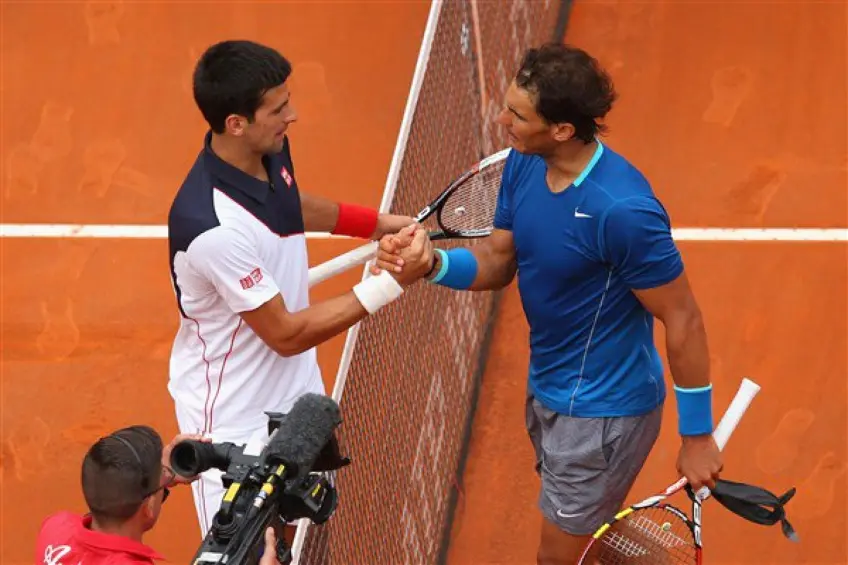
In the annals of tennis history, few challenges loom as large as defeating Rafael Nadal on the red clay of Roland Garros, a feat Novak Djokovic has described with vivid intensity. The Serbian superstar, a 24-time Grand Slam champion, recently opened up about the Herculean effort required to topple the “King of Clay,” likening the task to scaling an insurmountable peak. “Nadal on clay was a big mountain to climb,” Djokovic said, his words carrying the weight of a rivalry that has defined an era. This reflection, shared as Djokovic navigates the 2025 clay season, underscores the monumental nature of his victories over Nadal on the Spaniard’s favored surface.
The Djokovic-Nadal rivalry, spanning 60 matches over nearly two decades, is the most prolific in men’s tennis history. On clay, Nadal’s domain, the Spaniard holds a commanding 20-9 lead, with eight of those victories coming at Roland Garros, where he has claimed 14 French Open titles. Yet, Djokovic, the only active player to defeat Nadal at the French Open, has carved out nine clay court wins against him, a record unmatched by any other player. “To confront Nadal on the central court of Roland Garros, where he has had so much success, is the greatest challenge which exists,” Djokovic remarked in 2021, a sentiment that still resonates as he reflects on their battles.
Djokovic’s first clay court triumph over Nadal came in 2011 at the Madrid Masters, a breakthrough that shattered Nadal’s 37-match winning streak on the surface. “My first clay-court win over Rafa came in Madrid last year, and it was a massive triumph for me,” Djokovic recalled. The 7-5, 6-4 victory, achieved in a packed stadium pulsating with energy, marked a turning point. Djokovic’s relentless baseline play and pinpoint backhand neutralized Nadal’s ferocious topspin, proving the Spaniard was not invincible. “It was a massive success for me and a confidence boost, allowing me to believe I can beat Rafa on clay and win notable titles on this surface,” he added.
The 2013 Monte Carlo Masters final stands out as another pinnacle. Djokovic ended Nadal’s eight-year reign at the event, winning 6-2, 7-6(1). “I played one of my best matches on clay,” Djokovic said, noting the victory’s significance. “It took me years to try to figure out this puzzle and formula for beating Nadal on clay.” His tactical evolution—flattening forehands, mixing drop shots, and dictating rallies—allowed him to disrupt Nadal’s rhythm, a strategy he refined over years of grueling encounters.
Perhaps the most iconic of their clay court clashes was the 2021 French Open semifinal, a four-set epic that Djokovic called his best match at Roland Garros. Trailing after Nadal’s 6-3 first set, Djokovic battled back, winning 3-6, 6-3, 7-6(4), 6-2 in a match that stretched beyond the Paris curfew. The third set alone, a 93-minute marathon, showcased Djokovic’s resilience and Nadal’s unrelenting intensity. “Each time you step on the court with him, you know that you have to kind of climb Mount Everest to win against this guy here,” Djokovic said post-match, paying tribute to Nadal’s dominance.
Djokovic’s ability to challenge Nadal on clay stems from his adaptability. Unlike Nadal, whose heavy topspin and relentless defense make him a “completely different animal” on clay, as Mats Wilander once noted, Djokovic’s game requires time to sync with the surface’s demands. “He needs two, three weeks before he starts playing well,” Wilander observed, contrasting Nadal’s immediate command. Yet, Djokovic’s persistence paid off, with wins in Rome, Madrid, and Monte Carlo, and a historic Olympic gold in 2024, where he defeated Nadal 6-1, 6-4 on the same Roland Garros clay.
These victories, though rare, highlight Djokovic’s mental fortitude and tactical genius. “Beating Nadal on clay is the ultimate test in tennis,” Andy Murray once declared, a view echoed by players like Stan Wawrinka and Dominic Thiem. For Djokovic, each win was a testament to years of refining his craft against a rival whose 90.5% clay court win rate remains unmatched. As Nadal’s retirement in 2024 closed their rivalry, Djokovic’s reflections reveal not just respect but awe. “I have the utmost respect for you—an incredible athlete and an incredible person,” he told Nadal after their final meeting, a poignant nod to a rivalry that pushed both to greatness.
At 37, Djokovic continues to chase history, with his 2024 Olympic gold marking a career Golden Slam. Yet, his candid admission about the “big mountain” of Nadal on clay underscores the magnitude of their battles. For fans, these matches—electric, punishing, and transcendent—remain the gold standard, a reminder of why Djokovic and Nadal are tennis’s ultimate titans.
Leave a Reply